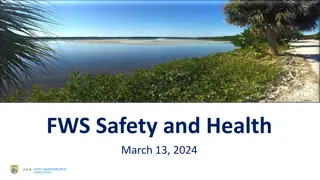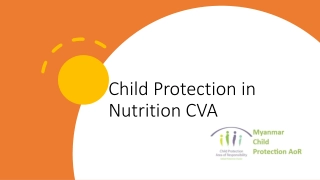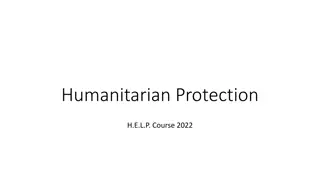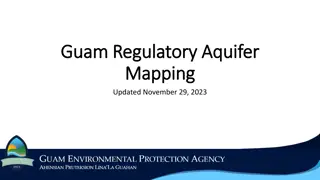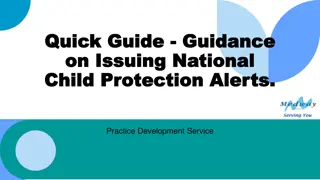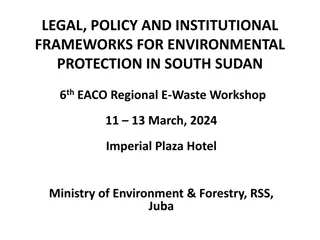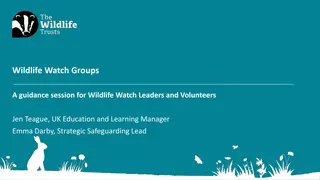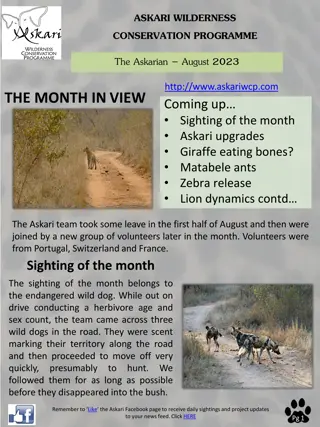Wildlife Protection and Welfare Issues in Nature and Captivity
Protection of wildlife in nature and captivity is crucial to prevent extinction due to habitat loss, pollution, poaching, and human intervention. Welfare issues of free-living wild animals are exacerbated by commercial exploitation and illegal activities like poaching, which pose serious threats to various species. Elephants, specifically targeted for their ivory tusks, suffer cruel fates as they are brutally killed for profit, highlighting the need for increased conservation efforts.
Download Presentation
Please find below an Image/Link to download the presentation.
The content on the website is provided AS IS for your information and personal use only. It may not be sold, licensed, or shared on other websites without obtaining consent from the author. Download presentation by click this link. If you encounter any issues during the download, it is possible that the publisher has removed the file from their server.
Presentation Transcript
PROTECTION OF WILD LIFE IN NATURE AND CAPTIVITY Dr. Mamta Assistant Professor
WELFARE ISSUES OF FREE LIVING WILD ANIMALS- Today more and more wild animals are getting extinct as a result of Habitat loss, Pollution, Human intervention, Commercial exploitation and other factors. humans have not utilized always the resources including wildlife, in a responsible manner, with the result that ecological process cannot continue to function properly and still sustain a diverse and healthy environment for the wildlife population.
POACHING Poaching has been defined as the illegal hunting or capturing of wild animals, usually associated with land use rights Why animals are poached? Until the 20th century most poaching was subsistence poaching Poaching is now usually done for sport or commercial profit, both in legal and black markets Poaching can be a serious threat to many wild species, Poachers sometimes kill or capture animals to sell them locally or for the global trade in wildlife. Some animals, such as birds, reptiles, and primates, are captured live so that they can be kept or sold as exotic pets. Slaughtered animals, on the other hand, have commercial value as food, jewelry, decor, or traditional medicine. In addition to killing for direct profit, poachers target animals to prevent them from destroying crops or attacking livestock. This happens to lions and elephants, as well as to wolves, and other predators
Poaching has devastating consequences for wildlife. In some instances, it s the primary reason why an animal faces a risk of extinction. Poaching for the exotic pet trade affects an animal s welfare in addition to its numbers in the wild. Most wild animals eat specialized diets found in nature, and they need space to fly, roam, and swing from branches. Captured animals are stuffed into boxes, suitcases, or sacks, and even if they survive transport, they often suffer in their new, unnatural situations poached animals can spread disease, such as Ebola and SARS
ELEPHANTS- Ivory tusks are actually massive teeth that protrude well beyond the mouths of elephants. Like our own teeth and those of many mammals these tusks are deeply rooted. Much of the tusk is made up of dentine, a hard, dense, bony tissue. And the whole tusk is wrapped in enamel, the hardest animal tissue and the part of the tusk that manages the most wear and tear. Elephant tusks evolved from teeth, giving the species an evolutionary advantage. They serve a variety of purposes: digging, lifting objects, gathering food, stripping bark from trees to eat, and defence. The tusks also protect the trunk another valuable tool for drinking, breathing, and eating, among other uses. An elephant weighs between 3-6 tons has tusk weighing an average of 27 kg. The process of procuring ivory is dreadful and cruel, the elephant must be killed before the ivory can be removed. This is being done by shooting, stoning, poison darts resulting in a slow painful death, or even machine guns slaughter of entire herds at waterholes Regardless of the mode of killing, the process of extracting the ivory is the same. In order to obtain ivory from the elephant, the hunter or poacher must cut into the head, to reach the approximately 25% of the ivory within the skull
TIGERS- Demand- their parts are used for traditional medicine, folk remedies, and increasingly as a status symbol among some Asian cultures. their pelts are valuable on the black market. In order to catch a tiger, steel traps are laid in known tiger trails. Once trapped the animal is left to struggle all night long so that it is exhausted from its attempts to escape and then a simple blow from a heavy stick is sufficient to kill the animal. Poachers also use poisoned carcasses of a tiger's prey to kill them. In the hot season they dig shallow pools and fill them with poisoned water
BEARS- Methods Poachers typically shoot their prey but they may also use poisoned bait to achieve their ends. Whilst the latter method may seem particularly reprehensible there is nothing sporting about the means poachers use to shoot their prey. They may use dogs to chase and corner a bear, they may set out bait to provide an easy meal for the animal and then shoot it whilst it s feeding or they may trap it, often by extremely inhumane means, and then shoot the bear hours or even days later. In addition live wild bears usually caught as cubs are used for a variety of entertainment purpose such as dancing (India, Pakistan, turkey) and bear baiting (Pakistan and formerly parts of Europe) Wild bears are also poached in various countries in Asia to supplement the breeding stocks of bear- bile farms found in those countries.
TURTLES- The illegal and unsustainable harvesting of sea turtle eggs for food and folk medicine contributes to low hatching rates. Destruction of beaches and the use of artificial lighting at night where the sea turtle species have major and minor nesting grounds, mating grounds, and feeding grounds are contributing to the indirect deaths of sea turtles and reducing their opportunities to bear successful offspring. Factors directly killing sub-adult and adult sea turtles are oil spills; ghost nets, loose or lots nets that drift in the sea; by catch, the accidental capture of unwanted sea life while fishing; as well as collisions between swimming sea turtles and vessels or their propellers. Both marine and fresh water turtles are hunted for their meat and for their shells In addition to being caught in the wild, some turtle species are also captive bred for commercial purposes, injuries sustained during capture most notably those caused by harpooning, will not kill the turtle immediately but causes prolonged pain and sufferings
STREET ENTERTAINMENT- All of them carry on because we believe that these people are poor and we do not understand the implication of their illegal trade. The main welfare concerned with these wild bird and animals are methods of catching from wild nature. All the animals and birds used by the streets entertainers are caught from the wild, regardless of whatever the madaris may say.
MAN WILD ANIMAL CONFLICT- Human Animal Conflict: is a direct result of habitat destruction where the animals wander into human habitation in search of prey and thus ends up being killed. Uncontrolled and unregulated grazing by domestic spreading of livestock - detrimental to the grazing area, dreadful diseases. It is reported that population of gaur has been dwindling as a result of death due to cattle borne diseases in many places of northeast India.
Encroachment of forest - Due to rapid increase in human population, shrinkage of landholding around protected areas lead to encroachment of forest by cutting trees, cultivation of crops etc. In these circumstances, wild animal may intrude in human habitat which generally ends up in the man animal conflict. there is always constant conflict between villagers with staff and wild animals, these conflicts will always leads to physical injury due to attack or death of animal.
Pilgrimages/ historical places Places of Pilgrimages/ historical places with in the protected areas will attract huge number of devotees/ pilgrims and tourists. the sariska tiger reserve has four important temples as well as historical places like kenkwari fort and pandopul. Roads/railway track- With advancement of transportation system, many roads, highway, railway tracts have been constructed/laid through protected areas to connect major cities. Presence of roads and tract has led to fragmentation of habitat, restricted the movement of animals during different seasons. There are many incidents of death of wild animals by accidents while crossing the tracts/roads. Corridors can be constructed below or over the tract/roads for the movement of animals. Railway department has made restriction in speed of train inside the park particularly in core areas.
Fire- Fire in the forest, causes disaster by large scale burning of vegetation important trees and death of wild animals. Fire can be natural, accidental, intentional and unintentional. Mining operation- Illegal mining is also cause for reduced living space for wild animals.
WELFARE ISSUES IN CAPTIVE ANIMALS- Zoos provide platform for scientific studies and exhibit to the public for purpose of education and recreation on a regular schedule basis. Earlier zoos were established for recreation and fancy. Subsequently the concept changed. Modern concept of zoo is mainly for Conservation, Public education, Research and Recreation.
IMPROPER HOUSING- Housing is very important in zoos as wild animals are always under stress due to captive condition. All the animal houses and enclosures should be equipped with resting platforms, bedding, boxes, open to sky raised platform etc as per the need of the individual species. The floor space and height of the roof must be adequate and as per the norm depending on species, size and behaviour of the animal. The outdoor area should have soft earthern floor while the indoor flooring should be made up of cement and concrete. For the animals which are having the burrowing habit eg. Rabbits, mongoose etc the floor must be cement and concrete. The floor should be smooth surfaced without any projected area. For the animals like rhinoceros or hippopotamus, there should be land as well as water ponds as per the biological needs of these species. Roof is not mandatory generally natural shade is used. However, artificial roof like asbestos sheet, polythene sheet, tiles can also be used. Adequate provision of ventilation, air circulation and maximum exposure to sunlight, should be ensured. During construction it should be kept in mind that it should have proper drainage facility and should be easy to clean.
Night cubicles are used for feeding of carnivores. Hay racks/trough for roughage feeding and feeding trough for feeding of concentrate is used for herbivores. Bears like to feed from elevated place. There should be provision of water trough in different animal housing. While designing the animal house, safety of animals, care takers and visitors must be considered. Separate enclosures should be provided to the animals during advanced pregnancy and also to the lactating mother with its recently born young ones. There should also be separate ward for sick animals, in proximity with veterinary dispensary within premises of the zoo. There must be provision of post mortem room nearby with the facilities of incineration of dead animals. Around the enclosure of the zoo there should be plantation of large flowering plants to provide shade which may add to the aesthetic value of the zoo
Cage/cubicle design- Behavioural construction of zoo. Based on the behavioural attributes of animals, the enclosure should be designed in near to their natural habitat. For one animals, height of the enclosure is more important than the floor space. Psychological space is more valuable than physical space. E.g.. Leopard like to rest on tree or crocodile like to wallow in water. Housing infrastructure should be enriched for proper behavioural expression of such animals. aspects of animals are very important during
Nutrition- Feeding of wild animals in captivity does not include only the provision of balanced diets but also require the skill of feeding management. Thus, basic knowledge about type of feeds consumed by different species and their nutritive value, feeding behaviour and nutritional requirement for various physiological functions in different species is necessary. Feeding of zoo animals is basically more difficult than that of farm animals. in most of the zoos, feeding is practiced by established thub rules and previous experiences By periodicals- exchange of information through newsletters, periodical etc. and updating the feeding system Obtaining information from donors zoos/agency- whenever a new animal is introduces (i.e. transfer of animal from one zoo to another zoo for breeding and sometimes orphans animal which are found in disturbed habitat), information about its feeding habit is obtained from the donor zoo/agency Domestic animal nutrition as a model- domestic animal nutrition as model for zoo animal feeding of wild animals is complex. Though the knowledge in zoo animals nutrition has considerably improved, but challenge still remain to meet the nutritional requirements for all physiological stages of life to achieve desirable results in term of health, reproduction and survivability
Behavioural enrichment through feeding techniques- A fundamental factor underlying the behaviour of man and animals has been their desire and need for food. Primates- food can be hidden away from the reach of apes and some tools like sticks, roped can be given to them Bears- honey is more relished by bear. Best way to give honey is to hang a sac containing honey on a tree or on high platform and make a small hole in it through which the honey drips down. Similarly termites infested rotten wood can be given, with this bear really become enthusiastic to obtain the source and get it after some effort Small cat- toys stuffed with raw feathers having scent of prey animals can be hidden somewhere in the enclosure to keep them active. Multiple small feeding of food also help a lot in keeping these cats busy Large cats- feeding whole animal carcass, joint and ligaments and meat etc. can also provide some aspect of predatory sequence Multiple small feedings, hiding the food at different places and then encouraging the animal to find it can also prove useful in keeping the animal active. food like poultry and fish can be provide once in a while to reduce monotony of eating meat of dead animals. Behavioural enrichment through feeding technique or other means not only offers a healthy environment for the animal to live but also provides the visitor with a better understanding of the animal behaviour by letting them to see the animal behaving natural Overcrowding- Most of the zoos are overcrowded with excess of animals. These overcrowding could be due to breeding of wild animals in captivity or due to shifting of rescued animals from human habitat.
WILDLIFE PROTECTION ACT The wildlife (protection) act 1972 is an act of the parliament of India enacted for protection of plant and animal species. It provides the basic framework to ensure the protection and management of wildlife Before 1972, India only had five national parks Among other reforms, the act established schedules of protected plants and animal species- hunting or harvesting these species was largely outlawed (penalty, fine , jail) The wildlife (protection) act 1972 (no. 53 of 1972) consists of 7 chapters, 6 schedules and 66 sections. This act has been amended in 1980. This act further amended as the wildlife (protection) amendment act- 2002, from 17th January, 2003. This act deals with all those matters related to wildlife in captivity, free range for conservation.
CHAPTER I (PRELIMINARY) 1. Short title, extent and commencement. It discusses about the terminologies and definition
Wildlife Wild animal Captive animals Circus includes any animal, aquatic or land vegetation which forms part of any habitat means any animal specified in Schedules I to IV and found wild in nature means any animal, specified in Schedule I, Schedule II, Schedule III or Schedule IV, which is captured or kept or bred in captivity means an establishment, whether stationary or mobile, where animals are kept or used wholly or mainly for the purpose of performing tricks or manoeuvres includes land, water or vegetation which is the natural home of any wild animal with its grammatical variations and cognate expressions, includes, (a) killing or poisoning of any wild animal or captive animal and every attempt to do so; (b) capturing, coursing, snaring, trapping, driving or baiting any wild or captive animal and every attempt to do so; (c) injuring or destroying or taking any part of the body of any such animal or, in the case of wild birds or reptiles, damaging the eggs of such birds or reptiles, or disturbing the eggs or nests of such birds or reptiles means an area declared, whether under section 35 or section 38, or deemed, under sub-section (3) of section 66, to be declared, as a National Park means a National Park, a sanctuary, a conservation reserve or a community reserve notified under sections 18, 35, 36Aand 36C of theAct Habitat Hunting National Park protected area
Zoo means a zoo recognised under section 38H zoo means an establishment, whether stationary or mobile, where captive animals are kept for exhibition to the public 2[and includes a circus and rescue centres but does not include an establishment] of a licensed dealer in captive animals sanctuary means an area declared as a sanctuary by notification under the provisions of Chapter IV of this Act and shall also include a deemed sanctuary under sub-section (4) of section 66 taxidermy , preparation or preservation or mounting of trophies vermin means any wild animal specified in Schedule V trophy means the whole or any part of any captive animal or wild animal, other than vermin, which has been kept or preserved by any means, whether artificial or natural, and includes (a) rugs, skins and specimens of such animal mounted in whole or in part through a process of taxidermy, and (b) antler, bone, carapace, shell, horn, rhinoceros horn, hair, feather, nail, tooth, tusk, musk, eggs, nests and honeycomb uncured trophy which has not undergone a process of taxidermy, and includes a [freshly killed wild animal, ambergris, musk and other animal products] vehicle means any conveyance used for movement on land, water or air and includes buffalo, bull, bullock, camel, donkey, elephant, horse and mule with its grammatical variations and cognate expressions, means the curing, means the whole or any part of any captive animal or wild animal, other than vermin,
CHAPTER II (AUTHORITIES TO BE APPOINTED OR CONSTITUTED UNDER THIS ACT) It discusses appointed which mostly includes- appointment of director, Appointment of Life Warden and other officers chief wildlife warden and other officers, power of delegates, constitution of wildlife advisory board, duties of the wildlife advisory board. 5. Power to delegate. 5A. Constitution of the National Board for Wild Life. 5B. Standing Committee of the National Board- an expert committee, constituted by IBWL considers amendments to the act, as and when necessary 5C. Functions of the National Board 6. Constitution of State Board for Wild Life. 7. Procedure to be followed by the Board. .8 Duties of State Board for Wild Life.
CHAPTER III (HUNTING OF WILD ANIMALS) Section 9 (prohibition of hunting)- No person shall hunt any wild animal in schedule I,II,II,IV except as provided under section 11 and 12.1 Section 11: hunting of wild animals to be permitted in certain cases Wildlife protection schedules- in accordance with the risk of survival of wildlife wee enlisted. Schedule Animals I Mammals, reptiles, amphibians, birds, crustaceans and insects II Few mammals and lizards, beetles, few mammals and snakes III Certain mammals (ungulates) IV Few rodents, most birds, certain snakes, tortoises, butterfies and moths V Vermins VI Specified plants
WLP act brought out 6 schedules related to plant and animal protection. 1-5 related to animal and 6threlated to plant Under this poaching (taking horn and skin of the animal), smuggling and illegal trades of animal under 1-4 schedule are prohibited Schedule 1(lion tailed macaque, rhinoceros, horn bill Hillock gibbon (AP), nilgiri tahr (state animal of TN), forest owlet, olive ridley turtle (travel from south America to India have huge nesting area in odisha coast, being threatened for their flesh, great Indian bustard (found in state of Rajasthan), dolphin, hangul, black buck, ) and part 2 of schedule 2 (king cobra, flying squirrel, Himalayan brown bear)- absolute protection are granted, high penalties are subjected eg in sh 1- Schedule 3 (hyenas, barking deer, nilgai) and 4 (vultures, sea kraits, star tortoises)- high protection, penalties are comparatively lower because their numbers are relatively higher Schedule 5 all vermin, they can be hunted- mice rat, crow, fruit bat Schedule 6- cultivation, collection, extraction, trade of plants is inhibited (, pitched plant)
a. The chief warden may permit any person to hunt such animal if he is satisfied that any wild animal specified in schedule 1 has become dangerous to human life or is so disabled or diseased as to be beyond recovery b. The chief warden or the authorized officer may, if he is satisfied that any wild animal specified in schedule II,III or IV has become dangerous to human life or to property (including standing crop on any land) c. Permit any person to hunt such animal or cause such animal to be hunted the killing or wounding in good faith of any wild animal in defence of oneself or of any other person shall not be an offence
Section 12 Grant of permit for special purposes- it shall be lawful for the chief wildlife warden, to grant a permit, which shall entitle the holder of such permit to hunt, subject to such conditions as may be specified therein, any wild animal specified in such permit, for the purpose of a) education b) scientific research c) scientific management (translocation of any wild animal to an alternative suitable habitat, or population management of wildlife, without killing or poisoning or destroying any wild animals) d) collection of specimen e) derivation, collection or preparation of snake venom for the manufacture of life saving drug provided that no such permit shall be granted; in respect of any wild animal specified in schedule list except with the previous permission of the central government 1[CHAPTER IIIA PROTECTION OF SPECIFIED PLANTS 17A. Prohibition of picking, uprooting, etc. of specified plant 17B. Grants of permit for special purposes.
CHAPTER IV 1[PROTECTED AREAS] (sanctuaries, national parks and closed areas)- it deals with declaration of sanctuaries, national parks and closed areas 18. Declaration of sanctuary. The State Government may, by notification, declare its intention to constitute any area other than an area comprised within any reserve forest or the territorial waters as a sanctuary if it considers that such area is of adequate ecological, faunal, floral, geo- morphological, natural or zoological significance, for the purpose of protecting, propagating or developing wild life or its environment.] 27. Restriction on entry in sanctuary. (1) No person other than, Apublic servant on duty, A person who has been permitted by the chief wild life warden or the authorised officer to reside within the limits of the sanctuary, Aperson who has any right over immovable property within the limits of the sanctuary, Aperson passing through the sanctuary along a public highway
Section 28 Grant permit- The chief wildlife warden may, on application, grant to any person a permit to enter or reside in a sanctuary for any of the following purposes, namely- a) investigation or study of wildlife and purposes ancillary or incidental thereto b) photography c) scientific research d) tourism e) transaction of lawful business with any person residing in the sanctuary (2) A permit to enter or reside in a sanctuary shall be issued subject to such conditions and on payment of such fee as may be prescribed. of Section 30 Causing prohibited- 32. Ban on use of injurious substances. 33. Control of sanctuaries. 33A. Immunisation of live-stock. (1) The Chief Wild Life Warden shall take such measures in such manner, as may be prescribed, for immunisation against communicable diseases of the live-stock kept in or within five kilometres of a sanctuary. (2) No person shall take, or cause to be taken or grazed, any live-stock in a sanctuary without getting it immunised.] No peron shall set fire to a sanctuary, or kindle any fire or leave any fire burning, in a sanctuary, in such manner as to edanger such sanctuary fire
35. Declaration of National Parks.Whenever it appears to the State Government that an area, whether within a sanctuary or not, is, by reason of its ecological, faunal, floral, geomorphological or zoological association or importance, needed to be constituted as a National Park for the purpose of protecting, propagating or developing wild life therein or its environment, it may, by notification, declare its intention to constitute such area as a National Park. 36A. Declaration and management of a conservation reserve 36B. Conservation reserve management committee 38. Power of Central Government to declare areas as sanctuaries or National Parks.
CHAPTER IVA (CENTRAL ZOO AUTHORITY AND RECOGNITION OF ZOOS) The central government shall constitute a body to be known as the CZA to exercise the power and to perform the function 38A. Constitution of Central Zoo Authority. (1) The Central Government shall constitute a body to be known as the Central Zoo Authority (hereinafter in this Chapter referred to as the Authority), to exercise the powers conferred on, and to perform the functions assigned to it under thisAct. (2) The Authority shall consist of (a) chairperson; (b) such number of members not exceeding ten; and (c) Member-Secretary, to be appointed by the Central Government.
Functions of the authority a) Specify the minimum standards for housing, upkeep and vermin care of the animal kept in a zoo b) Evaluate and assess the functioning of zoos with respect to the standards or the norms as may be prescribed c) Recognition and derecognition of zoos d) Identify endangered species of wild animals for purposes of captive breeding and assigning responsibility in this regard to a zoo e) Coordinate the acquisition, exchange and loaning of animal for breeding purposes f) Ensure maintenance of stud books of endangered species of wild animal bred n captivity g) Identify priorities and themes with regard to display of captive animals in a zoo h) Coordinate research in captive breeding and educational programmes for the purposes of zoos i) Provide technical and other assistance to zoos for their proper management and development on scientific lines j) Perform such other functions as may be necessary to carry out the purposes of this act with regards to zoos Recognition of zoos- No zoo shall be operated without being recognized by the authority Acquisition of animals by zoo- Subject to the other provisions of this act, no zoo shall acquire or transfer any wild animal specified in schedule I and II except with the previous permission of the authority Prohibition of teasing & etc, in zoo- No person shall tease, molest, injure or feed any animal or cause disturbance to the animals by noise or otherwise or litter the grounds in zoos
CHAPTER IVB - NATIONALTIGER CONSERVATION AUTHORITY 38L.Constitution of National Tiger Conservation Authority 38O. Powers and functions of Tiger Conservation Authority. (1) The Tiger Conservation Authority shall have the following powers and perform the following functions, namely: (A) to approve the tiger conservation plan prepared by the state government under sub-section (5) of section 38v of this act; (b) evaluate and assess various aspects of sustainable ecology and disallow any ecologically unsustainable land use such as, mining, industry and other projects within the tiger reserves; (c) lay down normative standards for tourism activities and guidelines for project tiger from time to time for tiger conservation in the buffer and core area of tiger reserves and ensure their due compliance; (d) provide for management focus and measures for addressing conflicts of men and wild animals and to emphasise on co-existence in forest areas outside the national parks, sanctuaries or tiger reserve, in the working plan code; (e) provide information on protection measures including future conservation plan, estimation of population of tiger and its natural prey species, status of habitats, disease surveillance, mortality survey, patrolling, reports on untoward happenings and such other management aspects as it may deem fit including future plan conservation;
(f) approve, co-ordinate research and monitoring on tiger, co-predators, prey, habitat, related ecological and socio-economic parameters and their evaluation; (g) ensure that the tiger reserves and areas linking one protected area or tiger reserve with another protected area or tiger reserve are not diverted for ecologically unsustainable uses, except in public interest and with the approval of the national board for wild life and on the advice of the tiger conservation authority; (h) facilitate and support the tiger reserve management in the state for biodiversity conservation initiatives through eco-development and people s participation as per approved management plans and to support similar initiatives in adjoining areas consistent with the central and state laws; (i) ensure critical support including scientific, information technology and legal support for better implementation of the tiger conservation plan; (j) facilitate ongoing capacity building programme for skill development of officers and staff of tiger reserves; and (k) perform such other functions as may be necessary to carry out the purposes of this act with regard to conservation of tigers and their habitat. (2) the tiger conservation authority may, in the exercise of its powers and performance of its functions under this chapter, issue directions in writing to any person, officer or authority for the protection of tiger or tiger reserves and such person, officer or authority shall be bound to comply with the directions: Provided that no such direction shall interfere with or affect the rights of local people particularly the Scheduled Tribes. 38V. Tiger Conservation Plan 38X. Establishment of Tiger Conservation Foundation.
CHAPTER IVC TIGER AND OTHER ENDANGERED SPECIES CRIME CONTROL BUREAU 38Y. Constitution of Tiger and other Endangered Species Crime Control Bureau.
CHAPTER V TRADE OR COMMERCE IN WILDANIMALS Wild animals etc. to be government property- Every wild animal, other than vermin, which is hunted under sec, 11 or sec. 29 or subsection (6) of sec 35 or kept or bred in captivity or hunted in contravention of any provision of this act or any rule or order made there under or found dead or killed by mistake including animal article trophy from any wild animal shall be the property of the state/ central government (sec 39) (a) wild animal, other than vermin, which is hunted under section 11 or sub- section (1) of section 29 or sub-section (6) of section 35 or kept or 1[bred in captivity or hunted] in contravention of any provision of this Act or any rule or order made there under or found dead, or killed 2*** or by mistake; and (b) animal article, trophy or uncured trophy or meat derived from any wild animal referred to in clause (a) in respect of which any offence against this Act or any rule or order made there under has been committed, (3) No person shall, without the previous permission in writing of the Chief Wild Life Warden or the authorised officer (a) acquire or keep in his possession, custody or control, or (b) transfer to any person, whether by way of gift, sale or otherwise, or (c) destroy or damage, such Government property.
Certificate of ownership- the chief wildlife warden may for the puposes of sec 40, issue a certificate of ownership in such form, as may be prescribed, to any person who in his opinion is in lawfull possession of any wild animal or any animal article, trophy or uncured trophy and may where possible mark in the prescribed manner such animal article trophy or uncured trophy for the purpose of identification (sec 42) Regulation of transfer of animal- person who do not possess a certificate of ownership shall not sell or offer for sale or transfer whether by way of sale, giftor otherwise, any wild animal specified in sch I or par II of sch 11 or any captive animal belonging to that category or any animal article, trophy, uncured trophy or meat derived there from (sec43) Restriction of transportation of wildlife- no person shall accept any wild animal (other than vermin) or any animal article, or any specified plant or part or derivative thereof for transportationexcept after exercising due care to ascertain that permission from the chief wildlife warden or any other officer authorized by the state govt in this behalf has been obtained for such transportation. Purchase of captive animal etc person other than a license- no person shall purchase, receive or acquire any captive animal, wild animal other than vermin or any animal article, trophy, uncured trophy, or meat derived there from otherwise than from a dealer or from a person authorized to sell or otherwise transfer the same under this act (sec 49) Chapter VA (prohibition of trade or commerce in trophies, animal article etc. derived from certain animals) Scheduled animals means an animal specified for the time being in schedule I or part 11 of schedule II. This chapter deals with prohibition of dealing in trophies, animal articles etc. derived from scheduled animals from on and after the specified date. Thus no person shall commence or carry on the business as a manufacturer of, or dealer in scheduled animal articles or any related business etc.
CHAPTER VI (PREVENTION AND DETECTION OF OFFENCES) Power of entry, search, arrest and detention The director or any other authorized by him in his behalf or the chief wildlife warden or the authorized officer or any forest officer or any police officer not below rank of a sub inspector may, if he has reasonable grounds for believing that any person has committed an offence against this act, has power to entry in the premises, issue search warrant, detention of the accused person depending on the situation (section 50) Penalties- Any person who contravenes any provisions of this act (except chapter VA and section 38J) or who commits a breach of any conditions shall be guilty of an offence and shall be punishable with imprisonment for a term which may extend to three years or with fine which may extend to twenty five thousand rupees or with both (secton 51) If the offence commited is in relation to any animal specified in scheduled I or part II
CHAPTER VII MISCELLANEOUS Protection of action taken in good faith No suit, prosecution or other legal proceedings shall lie against any officer or other employee of the central government or the state government for anything which is in good faith done or intended to be done (section 60) Reward to persons- When a court imposes a sentence of fine or a sentence of which fine forms a part, the court may when passing judgement order that the reward be paid to a person who renders assistance in the detection of the offence or the apprehension of the offenders out of the proceeds of fine not exceeding twenty percent of such fine (section 60A) Declaration of certain wild animal to be vermin- The central government may by notification, declare any wild animal other than those specifid in scheduleI and part II of schedule H to be vermin for any area for such period as may be specified there in and so long as such notification is in force, such wild animal shall be deemed to have been included in schedule V (section 62) Power of state/central government to make rules The central government may, by notification, make rules for all or any of the matters which will help in the protection of wild animals (section 63 for central, section 64 for state)










